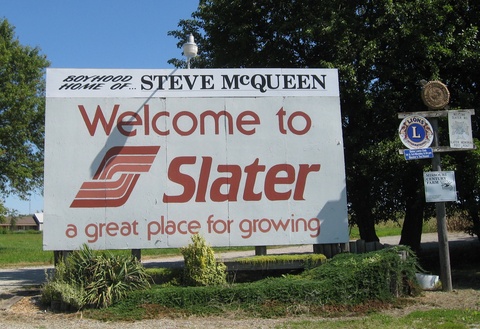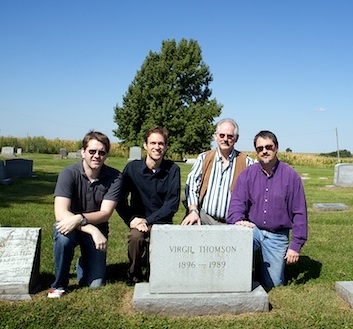David McIntire and I had been wanting to visit the grave of Virgil Thomson, and came up with a minimalism conference as the simplest way to create the opportunity. So early this morning four of us headed off for Slater, Missouri (pop. 2083), the town Thomson was born in. Only we found the town more willing to take credit for a different favorite son:
This led to my idea for my paper for the next conference: “The Great Escape and The Mother of Us All: Slater’s Impact on Modernism.” But I digress. We (that is, Scott Unrein, Andrew Granade, myself, and David) found Virgil between his parents and the sister who died in infancy, on a wind-swept plain between two cornfields:
After paying our respects, we stopped back through Lee’s Summit (home of Pat Metheny, similarly state-uncredited) for just about the best barbecue I’ve ever had, and certainly the hottest barbecue sauce, at an establishment called the Filling Station, which could only have been named for the ballet by Thomson:
For desert the place sold a rotund little candy bar called the Cherry Mash, which used to be my favorite sweet in the 1960s; I hadn’t had one in four decades, and couldn’t resist. For a few minutes I felt that maraschino paste on my tongue again and stepped back into the world of junior high school. It was horrifying.
Yesterday I got to hear sneak previews of a couple of conference papers. Andy Lee, UMKC doctoral student and pianist of postminimalism, in a paper analyzing David Borden’s two-piano piece Double Portrait, cited Jonathan Kramer’s distinction between vertical and horizontal time, vertical denoting a timeless stasis in which music seems to have no forward motion, horizontal indicating the more usual classical narrative of beginning, middle, and end. While minimalist composers are usually concerned with vertical time, postminimalist composers, Andy noted, are often ambiguous, concerned in some respects and times with the vertical, and in other respects and moments with the horizontal. I nearly leaped from my seat shouting “I confess, I confess!” and threw myself at his mercy, but he didn’t seem to hold the ambiguity against us. That’s one of those hidden-in-plain-sight truths that postminimalist composers tend to skirt around gingerly, but since several other papers deal with the postminimal, I look forward to the distinction being squarely faced and unraveled further throughout the week.




